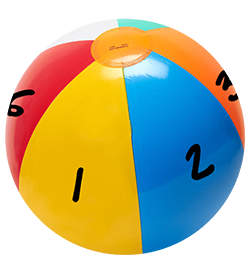Agricultural Literacy Curriculum Matrix
Companion Resource

Have a Ball – Your Sphere of Influence
Do you have a complicated issue or problem to discuss with your students? Use a beach ball (or any other type of ball) to demonstrate why a person might have a different "point of view." This activity helps students recognize that every issue can be seen from different points of view.
Time to Complete
Materials
- Ball (beach ball or soccer ball you can write on)
- Marker
Procedures
When it comes to current events and real-world issues in science and society, students often have difficulty sorting fact from opinion and viewing issues from multiple perspectives. It is important for students to understand that opinions are often based on biases, beliefs, and values rather than facts and evidence. The educational standards promote using evidence to approach and address conflicts, issues, and differences of opinion. Agricultural issues are relevant and provide students with an opportunity to evaluate evidence and inference, and to incorporate the viewpoints of others to address plausible solutions to complex problems.
- Write the numbers 1-4 or 1-6 on your ball.
- Now, stand in the middle of the room and hold the ball up for your students to see. Without rotating the ball, ask students in various points of the room which number(s) they can see. For example, ask a student in the front of the classroom what number he or she sees, followed by the same question to a student in the back of the room and so on. Each student will see all or part of different numbers.
- Ask your students, "Why, if you are all looking at the same object, a ball, are you seeing different numbers?" Explain that it is because each has a different “point of view.” Each student sees different numbers from their point of view. They may see an entire number or part of a number. There will be some numbers that they do not see at all.
- Use this object lesson to spring into a discussion about a situation or problem that requires that we look at the viewpoints of others to arrive at a workable solution. Explain that each person has a “point of view” and that when looking at or discussing issues people may use facts, opinions, or personal biases to defend and persuade others to see her or his point of view. Resolving issues and evaluating situations requires that we look at the viewpoints of others to arrive at workable solutions, to form realistic conclusions, or to make our own evidence-based decisions. Have a ball, and remind students that it is okay to agree to disagree. Life’s problems can be turned into issues that aren't so easy to solve, but by teaching your students to look at the facts in the context of various viewpoints they will hopefully become problem solvers and be able to make decisions.
- The folktale, “The Blind Men and the Elephant” may also be useful to further note different perceptions.
Possible Point-of-view Topics
- Use of antibiotics in dairy production
- Genetically Engineered (GMO) Foods
- Organic and Conventional Farming
- Plant-based Burgers vs. Traditional Beef
- World Food Sustainability
- Federal Land Use
- Climate Change
- Water use in agriculture
- Farm labor shortages
- Plastic bags vs paper bags vs cloth bags
- Food waste and ugly produce
- Lab grown meat
- Taxes on "junk food"
- Climate change
Identifying Credible Sources
This object lesson can be useful in teaching students how to identify credible research sources. As students evaluate information to make their own conclusions, they may need some guidance concerning credible sources. Here are a few tips:
- Recognize the differences between published and unpublished information. Just because something is published doesn’t mean it’s credible. Be especially careful when evaluating internet sources.
- Consider the date of the publication. Are the facts presented still relevant?
- Check out the authors. What are their credentials? Look at other publications by the same authors to determine any biases and consider the organizations they represent. Is there a conflict of interest?
- Determine if cited facts in a publication are derived from credible, published, peer reviewed, objective sources.
- Look for concurrence of facts between various credible sources.
- Evaluate the organization or the author’s use of a particular media choice and tone. Is he or she trying to incite, market to, or manipulate a particular audience? What stake does the author have in getting the reader to agree with him or her?
- Is the source of the information selling a product or service?





